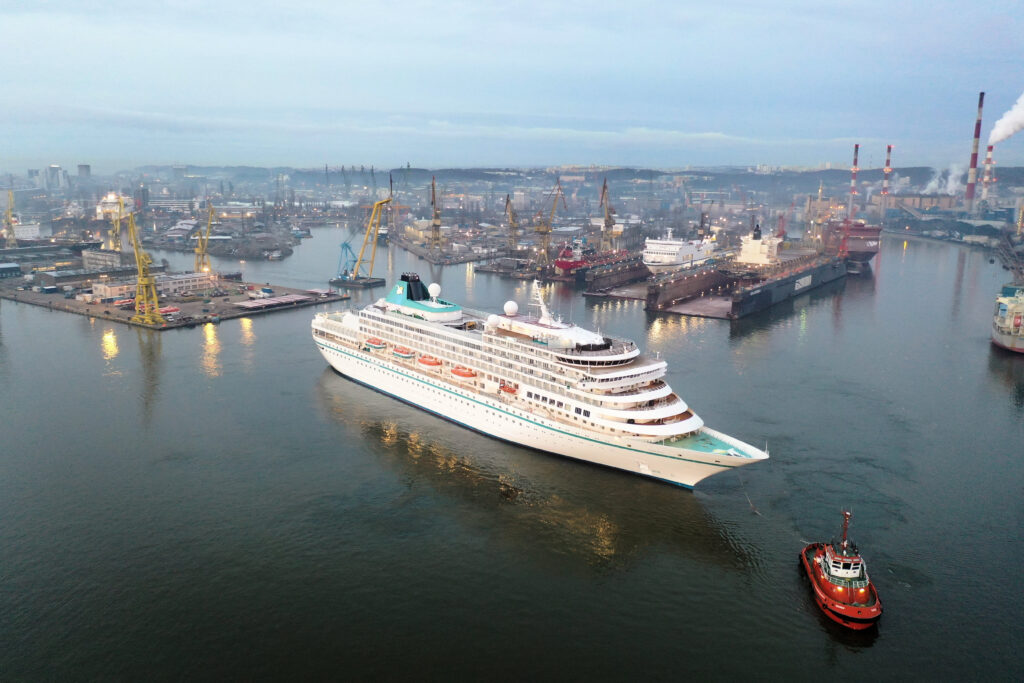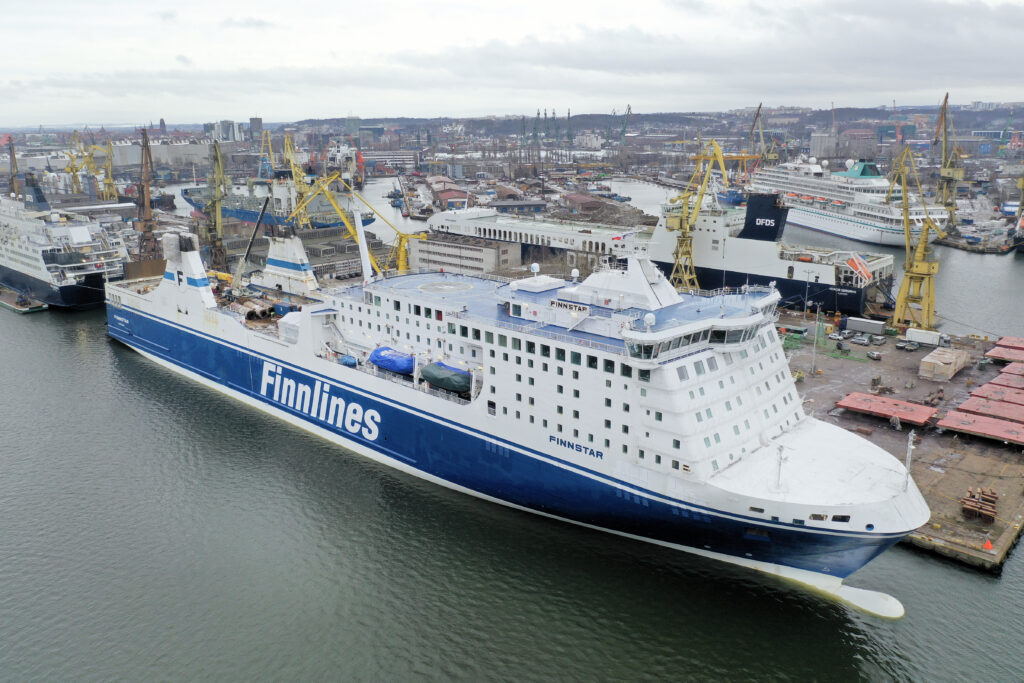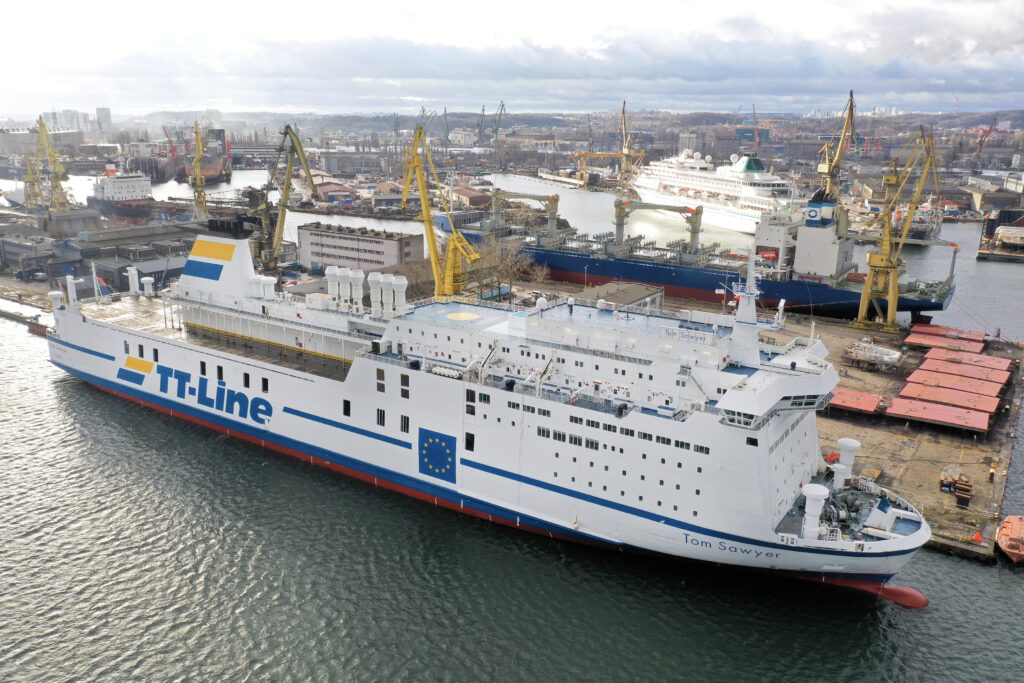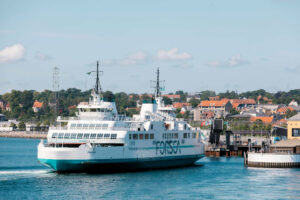Cruise & Ferry repairs in the spotlight
Early 2024 has seen Remontowa complete a project to convert the cruise vessel Amera, owned by Phoenix Reisen.
The yard upgraded the power and propulsion system so that Amera would meet the new energy efficiency and carbon footprint requirements, allowing it to navigate through various world regions for at least the next 20 years. At the same time, the yard retrofitted the engine room with new more efficient equipment to reduce the ship’s operating costs.
Remontowa replaced four main engines weighing 400 tonnes with new, more efficient ones weighing 35 tonnes each. Two new main gearboxes weighing 76 tonnes were also mounted, along with four new-type shaft generators that replaced the two previously operated. Three generating sets with a unit weight of 60 tonnes were dismantled, and the new shaft generators took over their roles.
The engine room was upgraded with new heat exchangers, pumps, fuel and oil separators, and filters. Around 100 tonnes of piping were dismantled, and over a thousand new pipe sections were installed.
Once the main engines and gearboxes were replaced, Remontowa tuned the new power system by setting the relevant parameters of the individual components. This was complemented by installing new propellers in the bow thrusters and replacing the controllable pitch propeller hubs. The azimuth thruster at the stern was removed, resulting in Amera gaining new room in this area. Remontowa also repaired the underwater section along the entire length of the ship. The saltwater ballast tanks were also converted to permanent ballast ones.
Remontowa completed a project to convert the cruise vessel Amera, in early 2024
Retrofits and repairs
At the end of 2023, the Finnstar Ro-Ro ship entered Remontowa to have its four existing scrubbers replaced with new ones. The shipyard also installed a new bow thruster, performed steelwork in the tanks and carried out hull maintenance.
The following two vessels, Finnmaid and Finnmill, came in during Q1 2024. Four scrubbing towers were replaced on Finnmaid, in addition to two exhaust system boilers and two boiler ends. All of the equipment in the funnel was first removed before the new scrubbing towers were mounted on foundations made at the shipyard, which connected the new equipment to the ship’s systems. The treatment of two rudder blades, overhauling a thruster and replacing the other were amongst other work. The seals on the propeller were replaced, and the stabiliser on the starboard side was refurbished. Piping and steel were renewed, including in the grey water tank.
The Finnmill underwent emergency repair with the shipyard reconditioning the propeller by machining it in the workshop. Tank cleaning was also performed.
The King Seaways and Victoria Seaways, which had already been refurbished at Remontowa in 2022, returned to the yard in early 2024. The main scope on the King Seaways included maintenance of the underwater part of the hull, repair of four propeller blades, including seal replacement, overhaul of the thruster, installation of a fire and bilge pump in the engine room and overhaul of the bio-block. On the Victoria Seaways, a BWT system was installed in a room on the deck. The propeller hub, blades, bow thruster and two stabilisers underwent overhauls. A large scope of work was applied to the stern ramp.
The Finnstar Ro-Ro ship entered Remontowa to have its four existing scrubbers replaced
Thorough overhaul
In 2024, the Normandie ferry (Brittany Ferries) underwent a thorough overhaul of its four main and two auxiliary engines at Remontowa, not to mention over 30 different types of pumps. The ferry’s stabilisers were also reconditioned, including disassembly and machining.
On the ferry Tom Sawyer owned by TT-Line, Remontowa renewed over 100 tonnes of steel. Much work was done on the stern and bow ramps, which underwent maintenance and liner overhaul. Lashings for large vehicles (TIR) were replaced on the car decks. In addition, inspections were carried out on coolers, heat exchangers, fans and electric motors. Pipelines were replaced in the engine room and superstructure.
Stena Line‘s first ferry to visit in 2024 was the Stena Jutlandica. The stern ramp underwent an overhaul, including repair and replacement of hinges. New auxiliary boilers, a waste heat boiler and an oil-fired boiler were installed, along with electrical connections.
One of the stabilisers was also reconditioned, the bow thruster replaced with a new one, and the propeller hub was dismantled and machined. A major task was installing the new marine evacuation system equipment, including an inflatable chute and liferafts with davits. The ferry also underwent routine maintenance work.

Remontowa renewed over 100 tonnes of steel on the Tom Sawyer owned by TT-Line
10 for Seatrium
Seatrium has secured a series of 10 cruise vessels from long-term partners Carnival Corporation and Royal Caribbean Group for retrofits in 2024. These include six cruiseships operating under Carnival’s various brands: Diamond Princess, Pacific Adventure, Carnival Splendor, Carnival Panaroma, Coral Princess and Noordam, as well as four cruiseships from the Royal Caribbean Group: Navigator of the Seas, Spectrum of the Sea, Quantum of the Seas and Celebrity Millennium.
Seatrium continues to play a vital role in contributing to Singapore’s position as a major hub for cruiseship repairs, upgrades and refurbishment. With the strong growth in global cruise tourism especially in Asia, Seatrium is well positioned to capture growing market opportunities in this market segment.
Significant growth for APCL
The APCL group of companies has experienced a significant period of growth from the start of 2024, with its three UK facilities operating at full capacity.
APCL Group brings together A&P Group, A&P Australia, Cammell Laird and Neway. A&P Group and Cammell Laird are the UK’s largest commercial ship building and repair operators, supported by blasting and painting company Neway Industrial Services.
A&P Falmouth was able to utilise No.3 Dock to accommodate the simultaneous docking of Red Eagle and Red Kestrel. The scope of work included hull cleaning and blasting, painting, replacement of steel in both hulls, tank cleaning, various inspections and other survey-associated work.
A&P Falmouth has also undertaken several projects for P&O Ferries, Wightlink and Stena Line to date.
Double docking
In the North West of the UK, Cammell Laird has experienced its busiest commercial period to date, with its four drydocks accommodating a variety of customers.
Since the start of 2024, Cammell Laird has welcomed three Stena Line vessels to its facility – Stena Edda, Stena Embla and Stena Adventurer. Stena Adventurer is the ninth ship to dock in the season and has undergone a large programme of work including extensive steel deck repairs, main propulsion system overhaul and other auxiliary work such as roller fairlead overhauls.
February saw Cammell Laird’s first double docking of 2024 – with CalMac Ferries’ Hebrides and Mersey Ferries’ Royal Iris of the Mersey simultaneously undergoing a programme of ship repair works in No.6 Dock. Following its annual overhaul, Calmac’s Caledonian Isles entered drydock at Cammell Laird for extensive steelwork repairs.
All vessels visiting Cammell Laird had their blasting and painting work completed by APCL Group company Neway Industrial Services.
Finnlines adopts graphene-based coating
Finnlines, in partnership with GIT Coatings, is accelerating its decarbonisation efforts by adopting XGIT-FUEL, an innovative graphene-based hard foul release hull coating across its Ro-Ro and Ro-Pax fleets. Starting with its first vessel in 2022, Finnlines has already applied this high-performance hull coating to four vessels as part of a recently-signed fleet agreement, reducing fuel consumption and emissions by around 7% compared to previously used coatings.
Over the past decade, Finnlines has invested significantly in its sustainability initiatives, dedicating hundreds of millions of euros to enhancing vessel performance and reducing carbon emissions. These investments have included the introduction of new, more efficient vessels and the upgrading of existing ones with advanced energy-saving technologies. One of the most recent projects involves the application of the low-friction hull coating XGIT-FUEL across its fleet, which helps to reduce fuel consumption and emissions by reducing vessel drag.
“Our commitment to sustainability is at the forefront of every decision we make,” says Thomas Doepel, VP and Deputy CEO at Finnlines, commenting on the initiative. “By integrating XGIT-FUEL into our fleet, we are not only reducing costs and advancing our environmental goals but also setting a new standard in the industry for environmental responsibility.”
Biocide-free coating
XGIT-FUEL is a biocide-free, hard foul release coating that offers an environmentally-friendly alternative to conventional toxic antifouling and soft-foul release hull coatings. In addition to reducing vessel drag, it incorporates graphene to enhance resistance to mechanical damage, making it more suitable for vessels sailing in icy conditions, and it can be cleaned without affecting the surface of the coating. Requiring only one layer, its application is more efficient compared to alternatives, and the temperature range for applying XGIT-FUEL, from -5 to 40°C, broadens the application period and enables Finnlines to enhance the performance of vessels scheduled for winter drydocking.
“Finnlines has been a great partner for us in many ways, and their openness to sharing data from their vessels has given us the opportunity to further validate the benefits of the coating,” explains Maiko Arras, the Director of Business Development at GIT. “It has become clear that Finnlines has reduced fuel consumption and carbon emissions by around 7% compared to the previous coatings on the vessels whose hulls have been coated with XGIT-FUEL”.
The application of XGIT-FUEL aligns with Finnlines’ broader strategy to enhance operational efficiency and sustainability, particularly under tightening regulatory conditions. The company plans to continue its partnership with GIT Coatings in the coming years, extending the use of XGIT-FUEL to additional vessels within its fleet, thus reinforcing its commitment to environmental stewardship and regulatory compliance.

Finnlines has adopted XGIT-FUEL across its Ro-Ro and Ro-Pax fleets
Power upgrades for Finnlines vessels
Manta Marine Technologies (formerly known as Yara Marine Technologies, YMT) has successfully completed installation and commissioning of onboard shore power systems for three Finnlines vessels: Finnlady, Finnmaid and Finnstar. These projects cement Manta Marine Technologies’ reputation as a provider of turnkey shore power solutions, which are likely to see higher take up by the maritime sector as it transitions to a low- and zero-carbon future.
The installations onboard the RINA-classed Finnlines Ro-Pax vessels support Finnlines’ commitment to decarbonising its fleet and reducing the environmental impact on shore-side communities.
“Finnlines has a long history of meeting strategic environmental aims by consistently setting short-term goals to reach excellent long-term results,” explains Thomas Doepel, Finnlines Deputy CEO. “We are proud to have partnered with Manta Marine Technologies on this pioneering initiative, and we are confident that shore power will play a crucial role in reducing our environmental footprint and GHG emissions.”
A valuable environmental tool
“Shore power is a valuable tool for shipowners looking to improve the environmental credentials of their vessels and I’m thrilled that our customer Finnlines has had such a positive experience with our team,” says Ina Reksten, Manta Marine Technologies CEO. “We look forward to more shipowners boosting their green credentials through use of our turnkey shore power solution as well as other products in Manta Marine’s portfolio.”
Manta Marine Technologies’ shore power team worked closely with Finnlines to minimise vessel downtime and ensure that the new equipment was installed as seamlessly as possible. The former worked to prepare the vessels for shore power, whilst Finnlines — in collaboration with the port authorities — developed a cable management system for the quayside.
The first phase of the installations took place in spring 2023 and involved some preparatory work being performed while the vessels were sailing, as well as when the vessels were alongside. The MMT team ensured that the detailed design was completed simultaneously and performed Factory Acceptance Testing. The initial power transfer trial took place onboard the Finnmaid at the port of Helsinki in December 2023 and demonstrated that the system performs exactly as expected.
“The installation took 10 months from start to completion on the first vessel, but this is due to specific long-lead items back in 2022,” explains Carl Fredrik Erikson, responsible for Manta Marine Technologies’ Shore Power Project Management. He adds that installation times will be reduced due to shorter delivery time now.
“That said, they could also become longer if the whole market decides to invest at the same time,” Erikson continues, pointing out that a number of operators are considering retrofit installations for their fleets. “Our class-approved and well-functioning shore power system is relatively unique for complex high-voltage shore power retrofits. We believe that our engineering approach aligns very well with the needs of the existing global fleet.”
This successful project was followed by the successful commissioning of the Finnlady in early 2024, followed closely by the Finnstar.
Power upgrade for Hamlet
Echandia, a leading Swedish maritime battery system supplier, has received an order from Öresundslinjen for the conversion of the ferry Hamlet from fossil fuel dependency to full electrical operation. The battery system is scheduled for delivery in the first half of 2025.
Operating on the Helsingør–Helsingborg route, Hamlet traverses the Öresund strait up to 8,000 times a year. The battery system is tailored for a minimum operational lifespan of 10 years without requiring battery replacement. Furthermore, the battery can be recharged in both ports in as little as 11 minutes on average.
“After evaluating multiple battery suppliers for this significant conversion project, the superior lifetime and lower weight of the Echandia battery system stood out as the primary reasons why Echandia emerged as the optimal choice for us,” says Kristian Durhuus, CEO at Molslinjen. “These factors contribute to the lowest Total Cost of Ownership (TCO) and environmental footprint when compared to other options.”
“This order once again demonstrates the recognition of Echandia’s battery systems within the maritime market, particularly in Denmark,” says Morten Larsen, Regional Director EU at Echandia. “Following the successful deployment of harbour buses in Copenhagen in 2020 and securing the contract for Molslinjen’s Ro-Pax ferries Als and Samsö in 2022, it is evident that Danish shipowners are increasingly valuing the advantages of Echandia when evaluating battery system options. We are honoured to have been chosen by Öresundslinjen, a leader in maritime electrification, for this significant project.”

Echandia has received an order from Öresundslinjen for the conversion of the ferry Hamlet from fossil fuel dependency to full electrical operation
Servicing the world’s largest cruise company
MAN Energy Solutions, MAN Energy Solutions USA and Carnival Corporation, the world’s largest cruise company, have signed a service agreement (LTSA) for five of Carnival’s Vista Class cruiseships powered by MAN 48/60CR type engines. The scope of the agreement covers the management of all maintenance, including planning, parts, technical advisory service, training and remote monitoring support.
MAN Energy Solutions will manage the agreement via MAN PrimeServ, its after-sales brand.
“This partnership enhances our engine management programme, which includes 24/7 remote monitoring and support as well as early anomaly detection and preventive maintenance capabilities,” explains Riccardo Cordara, AVP, Fleet Asset Management/Corporate Maritime Operations of Carnival Corporation. “In addition, this collaboration will explore new opportunities to further reduce our Greenhouse Gas emissions as part of our decarbonisation effort.”
MAN PrimeServ views the LTSA as a fundamental first step in transforming the companies’ relationship toward a more structured partnership, bringing more dedicated daily communication and the opportunity to identify and respond to the evolving long-term challenges and interests of both companies. It attributes the agreement to an existing interest in working closer together and the already excellent relations between the parties.
“The basic LTSA will produce several, immediate benefits to Carnival Corporation in the form of lower costs, greater price predictability and reliable performance,” says Chris Gray, MAN PrimeServ Head of O&M Contracting and Sales. “These will result largely from better planning, reduced administration, more efficient resource allocation and intensified communication.”
Read more articles like this in the latest issue of DryDock magazine




